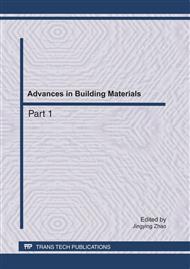p.84
p.89
p.93
p.98
p.104
p.111
p.115
p.120
p.125
Chloride Diffusion Characteristics of the New Interface Transition Zone in Recycled Aggregate Concrete
Abstract:
A three-part model (mortar, original concrete and ITZ) was established in this study to analyze the chloride coefficient of the new interfacial transition zone (ITZ) in recycled aggregate concrete (RAC). Based on this model, a formula for calculation was derived from the chloride transport characteristics in the steady state. Two types of RAC were used to study the properties of ITZ by steady-state migration test and Scanning Electron Microscope (SEM) method. The results indicate that the chloride diffusion coefficient of new ITZ in RAC is about 1 to 4 cm2/year, and that the addition of superfine phosphorous slag (PHS) not only reduces the chloride diffusion coefficient of mortar but also decreases the thickness and the chloride diffusion coefficient of new ITZ in RAC due to its pozzolanic reaction effect. The chloride permeability of mortar containing 20% PHS is only 1/5 of that in normal RAC. The chloride diffusion coefficient of ITZ in normal RAC is about 10 times greater than that of ordinary mortar. When modified with PHS and superplasticizer, the permeability of chloride in new ITZ is 3 to 7 times greater than that in the ordinary bulk cement paste. Furthermore, the mechanism and the effects of superfine phosphorous slag (PHS) on the resistivity of chloride permeation were discussed on basis of the experimental results and the images of SEM.
Info:
Periodical:
Pages:
104-110
Citation:
Online since:
May 2011
Authors:
Price:
Сopyright:
© 2011 Trans Tech Publications Ltd. All Rights Reserved
Share:
Citation:


